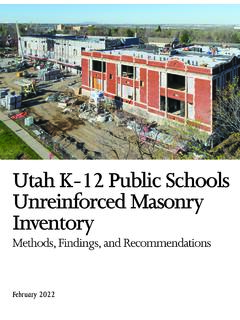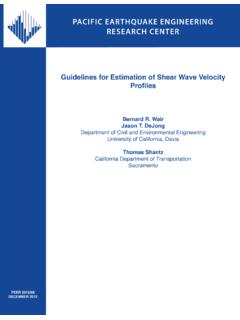Transcription of The Impact of School Infrastructure on Learning - ed
1 The Impact of School INTERNATIONAL DE VELOPMENT IN FOCUS. Infrastructure on Learning A Synthesis of the Evidence Peter Barrett, Alberto Treves, Tigran Shmis, Diego Ambasz, and Maria Ustinova INTERNATIONAL DEVELOPMENT IN FOCUS. The Impact of School Infrastructure on Learning A Synthesis of the Evidence Peter Barrett, Alberto Treves, Tigran Shmis, Diego Ambasz, and Maria Ustinova 2019 International Bank for Reconstruction and Development / The World Bank 1818 H Street NW, Washington, DC 20433. Telephone: 202-473-1000; Internet: Some rights reserved 1 2 3 4 21 20 19 18. Books in this series are published to communicate the results of Bank research, analysis, and operational experience with the least possible delay. The extent of language editing varies from book to book. This work is a product of the staff of The World Bank with external contributions.
2 The findings, interpre- tations, and conclusions expressed in this work do not necessarily reflect the views of The World Bank, its Board of Executive Directors, or the governments they represent. The World Bank does not guarantee the accuracy of the data included in this work. The boundaries, colors, denominations, and other information shown on any map in this work do not imply any judgment on the part of The World Bank concerning the legal status of any territory or the endorsement or acceptance of such boundaries. Nothing herein shall constitute or be considered to be a limitation upon or waiver of the privileges and immunities of The World Bank, all of which are specifically reserved. Rights and Permissions This work is available under the Creative Commons Attribution IGO license (CC BY IGO) http://.
3 Under the Creative Commons Attribution license, you are free to copy, distribute, transmit, and adapt this work, including for commercial purposes, under the following conditions: Attribution Please cite the work as follows: Barrett, Peter, Alberto Treves, Tigran Shmis, Diego Ambasz, and Maria Ustinova. 2019. The Impact of School Infrastructure on Learning : A Synthesis of the Evidence. International Development in Focus. Washington, DC: World Bank. License: Creative Commons Attribution CC BY IGO. Translations If you create a translation of this work, please add the following disclaimer along with the attribution: This translation was not created by The World Bank and should not be considered an offi- cial World Bank translation. The World Bank shall not be liable for any content or error in this translation.
4 Adaptations If you create an adaptation of this work, please add the following disclaimer along with the attribution: This is an adaptation of an original work by The World Bank. Views and opinions expressed in the adaptation are the sole responsibility of the author or authors of the adaptation and are not endorsed by The World Bank. Third-party content The World Bank does not necessarily own each component of the content con- tained within the work. The World Bank therefore does not warrant that the use of any third-party- owned individual component or part contained in the work will not infringe on the rights of those third parties. The risk of claims resulting from such infringement rests solely with you. If you wish to re-use a component of the work, it is your responsibility to determine whether permission is needed for that re-use and to obtain permission from the copyright owner.
5 Examples of components can include, but are not limited to, tables, figures, or images. All queries on rights and licenses should be addressed to World Bank Publications, The World Bank Group, 1818 H Street NW, Washington, DC 20433, USA; e-mail: ISBN: 978-1-4648-1378-8. DOI: Cover photo: @Tigran Shmis, Central Space of Aurora School , Espoo, Finland. Used with the permission of Tigran Shmis. Permission required for reuse. Cover design: Debra Naylor / Naylor Design Inc. Contents Preface v Acknowledgments vii About the Authors ix Executive Summary xi Abbreviations xv CHAPTER 1: Introduction 1. Context 1. Methodology 2. References 3. CHAPTER 2: Access to Education Infrastructure 5. Introduction 5. Optimal size of schools 5. Class size and density 6. Learning spaces and educational technology 8. Implications for equity 9.
6 Summary 10. Notes 11. References 11. CHAPTER 3: Safe and Healthy School Buildings 13. Introduction 13. Impact on pupils 13. Impact on teachers 14. Scale of the problem 15. Equity implications 15. The dynamics at play 16. Summary 17. References 18. CHAPTER 4: Baseline Conditions for Learning 21. Introduction 21. Evidence for the Impact of particular factors on Learning 22. Evidence of holistic Impact of School spaces on Learning 23. Summary 28. Notes 29. References 29. iii iv | The Impact of School Infrastructure on Learning CHAPTER 5: Links between School Design and Pedagogy and Community 33. Introduction 33. Pedagogy and space 33. Improving schools and increasing community wellbeing 36. Summary 38. Notes 39. References 39. CHAPTER 6: The Process of Effective Planning and Implementation 41. The need for dialogue 41.
7 The need for ambition 42. The need for inspiration 43. The need for a long-term, holistic perspective 43. Summary 44. Notes 45. References 45. CHAPTER 7: Summary and Conclusions 47. Summary 47. Implications for future practice 49. Implications for future research 50. Conclusions 51. Reference 51. Box OECD earthquake seismic safety recommendations 14. Figures Learning environments for better educational outcomes 2. Contribution of each classroom measure 26. Learning interactions: Teacher, spaces, and pedagogy 35. Tables Summary of literature reviews on the Impact of School buildings on Learning 22. Classroom characteristics that increase pupils' ability to learn 28. Preface Governments and societies around the world strive to improve their education systems and ensure that all children and youths have the opportunity to go to School and acquire the knowledge and skills they need to lead healthy and pro- ductive lives.
8 Key inputs to the education system, such as curricula, teachers, and education Infrastructure , help to improve the quality of education. The quality of education Infrastructure , specifically its appropriate educa- tional planning and design with a focus on child development, has been widely discussed in recent years. The Sustainable Development Goals 1, which are defined by the United Nations and scope the development agenda for all coun- tries in the world, require countries to build and upgrade education facilities that are child, disability and gender sensitive, and provide safe, non-violent, inclusive, and effective Learning environments for all. Many stakeholders around the world are seeking evidence on how various Learning settings may positively or negatively affect child development. The Inter-American Development Bank (IDB), Organisation for Economic Co-operation and Development (OECD), United Nations Educational, Scientific and Cultural Organization (UNESCO), Council of Europe Development Bank (CEB), and the World Bank are doing analytical work to answer the question of how to design schools that are efficient, inclusive, and conducive to Learning .
9 Moreover, the World Bank and other international financial institutions have large and diverse investment portfolios on School Infrastructure in different parts of the world, amounting to billions of United States dollars. Therefore, there is a need for more evidence on the effectiveness of these educational Infrastructure investments. The potential benefits of improving the spaces where education is provided can be sizeable, including energy savings, safer and healthier environments for chil- dren, and better Learning outcomes. Recent studies have shown that students' performance is enhanced in schools with better physical Learning environments. As this report will show, the empir- ical argument for investing in Learning environment is strong. Furthermore, although causal evidence on this topic is scarce, there is a growing number of non-experimental studies many of them compiled here that indicate that investments in quality School Infrastructure are strongly associated with v vi | The Impact of School Infrastructure on Learning improved Learning outcomes even after controlling for students' socioeconomic background and other relevant covariates.
10 New technologies and emerging pedagogical practices have created new requirements for educational buildings. As a result, new approaches to building Learning environments must be devel- oped that both create better spaces for children and increase the efficiency of investments in educational Infrastructure . The planning of good Learning spaces is a discipline that combines different sciences and that requires the involvement of all users of these spaces teachers, parents, and children in the decision-making process for Infrastructure devel- opment. Policymakers could do more to include these groups in the envisioning, coordination, and planning of specific Infrastructure projects. The evidence base related to the Impact of Learning environments on aca- demic outcomes is gradually growing across the world.

















